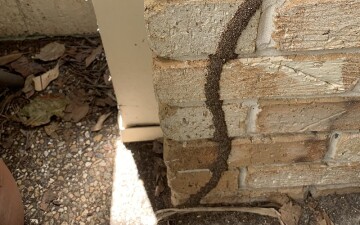- Home
- Importance of Weep Holes
Importance of Weep Holes
What Are Weepholes?
 Weepholes are the gaps left between some bricks in external walls. Australian Standards require them because they serve two important purposes:
Weepholes are the gaps left between some bricks in external walls. Australian Standards require them because they serve two important purposes:
1. Ventilation of the internal wall cavity - Without ventilation, mildew, dry rot and damp reduce the life of the internal wall studs and other building materials within the cavity. Inadequate ventilation is the main cause of "Leaky Building Syndrome".
2. Drainage - Water that enters the cavity due to capillary action, condensation, damage, or accidental flooding needs to escape somewhere. In tropical and sub-tropical areas of Australia it is not unusual to see water flowing from the weep holes in walls on the prevailing side of well constructed brick houses after a 'gully raker' or monsoonal storm.
Problems With Weepholes
1. Pest Entry
 If weep holes are left unprotected in brick walls they provide access to the wall cavity for rodents and insects. Swarming bees and European Wasps love creating nests in cavities. Field mice make a track through the weep holes looking for warmth. Snakes, cockroaches and spiders find refuge, and food, in the cavity. Down lights, extractor fans and holes for plumbing or electronics become the internal entry point for these unwelcome visitors.
If weep holes are left unprotected in brick walls they provide access to the wall cavity for rodents and insects. Swarming bees and European Wasps love creating nests in cavities. Field mice make a track through the weep holes looking for warmth. Snakes, cockroaches and spiders find refuge, and food, in the cavity. Down lights, extractor fans and holes for plumbing or electronics become the internal entry point for these unwelcome visitors.
In desperation many occupants resort to blocking weepholes in brick walls with any number of materials such as silicon sealants, rolled up paper, plastic, scourer pads, steel wool. Even some manufactured weep hole covers, guards and barriers have been designed with holes too small to allow adequate ventilation. These 'solutions' that obstruct air-flow to the cavity cause Leaky Building Syndrome which can be difficult and very costly to fix later.
Solution: If you're building you can have perfect vermin free weepholes from the start by using one of our construction products. If you've already built, our Protector Weep Hole Screen can be easily installed to keep these pests out whilst maintaining air-flow.
2. Termite Entry
 Weepholes in brick walls are a serious free entry point for termites. It's common to see garden mulch, timber and other refuse against brick walls, enabling termites to use them as a bridging point into the cavity. Pest Managers are on the look out for this in their inspections but the damage can be done quickly and invisibly.
Weepholes in brick walls are a serious free entry point for termites. It's common to see garden mulch, timber and other refuse against brick walls, enabling termites to use them as a bridging point into the cavity. Pest Managers are on the look out for this in their inspections but the damage can be done quickly and invisibly.
Solution: Weepa’s Termite Protector Weep Hole Screen, made from bifenthrin infused plastic can be easily installed to deter termites for up to 2 years. Bifenthrin is also known to deter ants and cockroaches and early anecdotal studies are very promising. If you also need bushfire protection this product can by used in conjunction with our stainless steel Protector Weep Hole Screen.
3. Entry Point for Sparks and Embers during Bushfires.
Weep holes provide access for embers during bushfires sometimes with devastating consequences. Sparks enter the wall and roof cavity and the house ignites ‘from the inside’. It’s common to hear stories about firefighters saving houses in the direct path of a bushfires only to find houses further back suddenly exploding into flames.
In Australia the Building Code for bushfire-prone areas (AS3959:2018) has specific requirements for ember screening in weep holes in brick walls in all houses built in areas of declared bushfire risk including BAL-A12.5, BAL-A19, BAL-A29, BAL-A40, BAL-FZ.
Solution: Our range of Bushfire Compliant Products for use during or after building help you to meet Australian Standards and prevent the entry of embers and keep the cavity safe.
Weep Holes - Statutory Requirements
Building requirements - The Australian Standard AS 3700-2018 for Masonry Structures Section 4.7.2 says "Weepholes shall be provided to drain moisture from or through masonry construction. Where flashings are incorporated in the masonry, weepholes shall be provided in the masonry course immediately above the flashing, at centres not exceeding 1200 mm."
Bushfire requirements - The Australian Standard for Construction in Bushfire Prone areas (AS3959:2018) stipulates that new buildings in bushfire prone areas require weep hole protection to prevent ember attack. It specifies the requirements for ember screening to meet the various Bushfire Attack Level (BALs). Specific BAL requirements for Weepholes
Your Architect or Building Designer will cover these requirements on your plans. And, your Building Certifier will sign off on them on completion of the project.